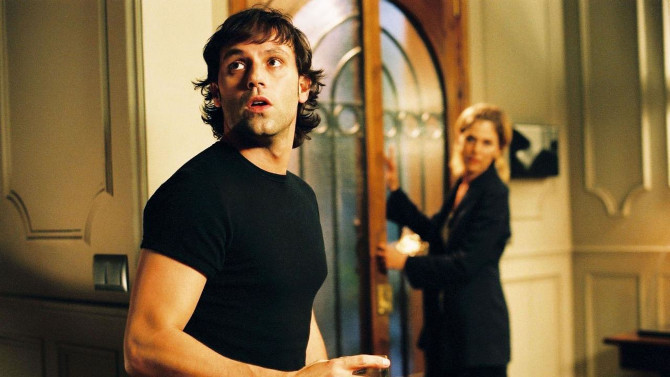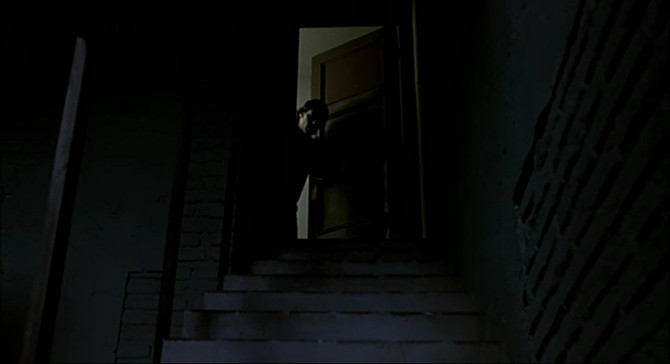Reveling in the motifs of Edgar Allan Poe, think madness/insanity, a haunting location, the double, the uncanny, and maybe even death, Guillem Morales (Julia’s Eyes) explores the recesses of the mind in his directorial debut (he also writes the screenplay), The Uninvited Guest (2004).
Who knew a four-thousand square foot home could be so claustrophobic. Félix (Andoni Gracia) finds himself alone in the weeks following the break-up from his longtime wife, Vera (Mónica López). With her having moved into a tiny three-hundred and fifty square foot apartment, it baffles Félix’s mind. . . unable to comprehend how anyone could downsize so drastically.
An architect, his entire life revolves around size, space, and design. He is unbelievably proud of the redesign he has done on his massive abode – full of trap doors (the old room behind the hidden library panel trick), modernist touches (self shutting curtains, electronic locking doors), and four floors (if you include basement and expansive attic).
Utilizing a narrative formula of counting day after day, the real suspense starts when a man, shrouded in shadow, knocks on his door late one night. Without a cell phone, and with the payphone outside supposedly not working (or is it?), he demands to make an urgent and private call – going so far as to ask for some space. Leaving the room, when he returns a couple of minutes later, the stranger is gone.
Unsure as to whether he has departed or hidden somewhere in the home, after a brief search, he goes to bed. . . only to be woken in the middle of the night by a creaking sound. Slowly seeping into his subconscious, paranoia starts to creep in. Each crackle and squeak, typical of every house, becomes a possible sign of this ‘second resident’ – could it be that he might just be able to blend into the woodwork?
Calling his ex for help, she can sense his fear. . . though unable to comprehend how he could believe that someone is able to constantly hide in a house that is being lived in. Delving deep into an obsessive, nerve-tingling madness, some parallels could be drawn to the unnamed narrator in Poe’s “The Tell-Tale Heart”.
After a freak accident in his home (a second one will occur a bit later), he must make a visit to the police station. . . seeing a redheaded woman in a wheelchair who looks like a doppelgänger of his ex (also played by López), he soon becomes obsessed with her. . . and her missing husband – who might have been the elusive late night visitor.
Flipping the script in a most intriguing way, it must be seen to be believed. Furthering the voyeuristic feel of the piece, Félix’s mania takes a unique turn, just as obsessive, equally as twisted, making us further question our main character. How does this world of the double, with ex-wife lookalike living in a big home with her husband gone from it, tie into Félix’s unrelenting story? Might that old gothic term of ‘the uncanny’ be a perfect descriptor for what is happening? Could all of this be in his head, or is something ‘real’ actually going on here?
With locked doors, one with a hidden key hiding some unknown secret, another used to lock something away in the attic, it seems fittingly symbolic that this is an illustration of Félix’s mind. Attempting to hide feelings of lost love, desires, and utter frustrations away in the recesses of his psyche, this uninvited visitor brings all of these feelings, some of them unhealthy, to the surface. This really is a haunting picture, tragic in its story of lost love, an almost cosmic tease of the double that plays with those relationship feelings that have you yearning to be together with your beloved once more, the horror and thrills of life only accentuated by the almost surreal, albeit perhaps possible premise. It twists and turns in the cinematically dark shadows of the home, all leading to mystery, tragedy, question marks, and so much more. Lastly, it is also worth noting that at one point, his ex seemingly has a conversation with someone else in the kitchen (only for that person to be gone when Félix enters). . . a rather vexing clue that will only be revealed later on in the feature.
A most unique and creative movie (that also has a bit of a Hitchcock vibe), The Uninvited Guest was part of a boom of Spanish language horror films around this time. Fitting in with the likes of Morales’ other horror feature, Julia’s Eyes (2010), as well as The Orphanage (2007), The Skin I Live In (2011), The Body (2012), and Guillermo del Toro’s foreign language work – The Devil’s Backbone (2001) and Pan’s Labyrinth (2006) specifically (and, of course there are more), it would be wise for horror fans to explore this age of excellent motion pictures. So, invite yourself in to see this mesmeric thriller, just makes sure no one sees you in the shadows.
This film is in Spanish with English subtitles



